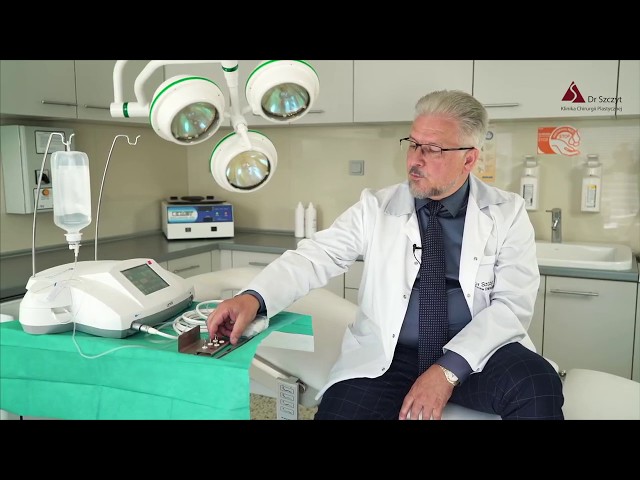Safety and risks in plastic surgery - what should you know before the procedure?

Modern technology and advanced techniques ensure that today plastic surgery is safer and more precise than ever before. However, any surgery, even those considered minimally invasive, carries certain risks. What are the risks associated with plastic surgery, and what precautions will help reduce complications? In this article, we'll look at these issues to help you make an informed decision and increase your safety throughout the process - from consultation to recovery.
Risks of plastic surgery - what should you know before surgery?
Plastic surgery, although it offers patients the opportunity to improve their appearance and increase their self-confidence, like any surgical intervention, comes with the risk of complications. Among the most common are reactions to anesthesia, risk of thrombosis, infection and hemorrhage. That's why choosing the right clinic and an experienced specialist is so important - it's worth entrusting your health in the hands of experts. In our clinic we use modern medical procedures, and by ensuring the highest safety standards, we significantly reduce the possibility of complications. Our experienced team will not only carry out the operation itself, but will also assess the patient's health in advance, ruling out possible contraindications, and provide professional care at every stage - from consultation to recovery.
Read also: Plastic surgery without secrets - what do you need to know before surgery?
Reactions to anesthesia
General or local anesthesia, although necessary for the procedure, can cause adverse effects that vary depending on the patient's individual response. Among the most common discomforts are:
- Nausea and vomiting, which can occur right after surgery or in the first hours after waking up,
- Severe headaches and dizziness, caused by the body's reaction to anesthetics,
- Excessive weakness and confusion, which may persist for several hours or days, especially in patients with low blood pressure,
- Allergic reactions to anesthetics, in extreme cases leading to anaphylactic shock.
Complications related to anesthesia are relatively rare, but nevertheless, before each operation, the patient undergoes a detailed anesthesiological qualification, in order to assess the condition and select the safest method of anesthesia.
Blood clots and risk of pulmonary embolism
Plastic surgeries, especially those lasting several hours or requiring a long period of immobilization after surgery, increase the risk of blood clots, which can lead to serious complications, including deep vein thrombosis (DVT) or pulmonary embolism (a condition in which a clot travels to the lungs, causing respiratory distress and, in extreme cases, threatening the patient's life).
To reduce the risk of thrombosis, doctors recommend:
- Use of prophylactic anticoagulant therapy in the form of blood-thinning drugs,
- Regular movement as soon as possible after surgery to stimulate circulation,
- Wearing compression stockings to promote blood flow in the lower extremities,
- Adequate hydration of the body, which helps reduce blood viscosity.
Infections - one of the most serious complications
Although plastic surgery is performed under sterile conditions, there is always some risk of infection of the surgical site. Infection can occur both as a result of bacteria present on the patient's skin and as a result of failure to observe hygiene rules during the postoperative period.
Symptoms of postoperative infection include:
- Redness and swelling around the wound,
- Severe pain that does not subside despite the use of painkillers,
- Purulent discharge from the wound,
- Fever and general weakness of the body.
Some infections may require antibiotic therapy and, in more severe cases, surgical re-intervention to clean the infected tissue. To reduce this risk, the patient should strictly adhere to the doctor's instructions for the care of surgical wounds, avoid touching them, and if there are alarming symptoms that may indicate a developing inflammation - consult a specialist.
Hemorrhages and hematomas - a threat to proper healing
One of the significant complications of surgery, including plastic surgery, is excessive bleeding, which can occur both during surgery and in the first days after surgery. In some cases, there can be a buildup of blood under the skin, or hematomas. If they are large, they may require additional intervention for removal.
Factors that increase the risk of hemorrhages and hematomas are:
- Use of anticoagulants or aspirin before surgery,
- Hypertension, which can lead to the bursting of blood vessels,
- Severe physical exertion after surgery, which may cause the sutures to be compromised,
- Inadequate care of the wound, leading to its reopening.
Specific risks associated with particular plastic surgery procedures
It is worth being aware that the more complicated the procedure, the greater the likelihood of unwanted side effects, which can affect both the appearance and functioning of the body.
Risks in facial plastic surgery - facelift, nose and eyelid plastics
Facial procedures, including facelift (facelift), eyelid correction (blepharoplasty) or nose surgery (rhinoplasty), require extreme precision. One of the biggest risks is nerve damage, which can lead to:
- Weakening or disappearance of facial expressions, causing difficulty in moving facial muscles,
- Asymmetry of facial features when one nerve is damaged more than others,
- permanent loss of sensation in the operated area, which is especially true for nose and eyelid procedures.
In addition, a facelift can cause abnormal skin tension, resulting in an unnatural appearance, and in the case of a poorly performed rhinoplasty, the complication is difficulty breathing, necessitating further corrective surgery.
Complications after breast surgery - augmentation, reduction and reconstruction
Breast plastic surgery procedures, including augmentation with implants, reduction or reconstruction after mastectomy, carry both aesthetic and functional risks. The most common complications are:
- Loss of sensation in the nipples (permanent or temporary),
- Breastfeeding problems, especially after breast reduction or breast lift, where milk ducts are damaged,
- the formation of scar tissue around the implants (known as connective tissue capsular contracture), which causes pain, breast deformation and the need to replace the implants,
- Breast asymmetry, resulting from uneven tissue distribution or improper placement of implants.
In addition, there is a risk of displacement or rupture of the implant. In such a situation, it needs to be removed and reoperated. In rare cases, infection also occurs, which can also lead to the need to remove the implant and long-term antibiotic therapy.
Risks of liposuction - from uneven skin to more serious complications
Liposuction, or liposuction, can lead to complications, especially if performed improperly or on large areas of the body. The most common adverse effects are:
- uneven skin and visible dimples if the fat is not removed evenly,
- Loose, sagging skin if the patient's skin elasticity is low and will not adjust to the new shape,
- Damage to nerves or blood vessels, causing long-term bruising, swelling or even tissue necrosis.
In extreme cases, especially when liposuction involves large areas of the body, there is a risk of fat embolism - fat particles enter the bloodstream and block blood vessels, leading to life-threatening complications.
Psychological consequences of plastic surgery
In most cases, surgeries help increase self-confidence and improve quality of life, but unfortunately, there are times when they lead to negative psychological consequences if the patient's expectations are not met.
- Body Dysmorphic Disorder ( BDD) - some patients, despite a well-executed procedure, continue to perceive themselves as having an imperfect appearance and continually seek further surgery.
- Post-operative depression - changes in appearance may require mental adaptation, and some patients feel disappointed or have difficulty accepting their new image after surgery.
- Plastic surgery addiction - some people, especially those with a tendency toward perfectionism, begin to undergo more surgeries on a regular basis, which can lead to an unnatural appearance and health problems.
Does the patient have a say in risk reduction?
The decision to undergo plastic surgery is an important step that requires not only emotional maturity, but also a conscious approach to the treatment process.
The right motivation and the real need for plastic surgery
The first step toward a safe procedure is a thorough reflection on the motivation for the procedure. Any plastic surgery should be based on the patient's real need - both physical and psychological. The question to ask yourself is whether the decision to have surgery stems from a personal desire to improve one's well-being, or is it the result of social pressure, peer expectations or aesthetic trends? People who make a conscious decision and have realistic expectations are more likely to be satisfied with the results and go through the recovery process more easily. It's also a good idea to consult an experienced specialist, who will assess whether the procedure will actually bring the expected benefits and not expose the patient to unnecessary risks.
Preoperative consultation - the key to an informed decision
As we have already mentioned, one of the most important factors affecting the safety of plastic surgery is the choice of the right clinic and an experienced surgeon who will first conduct a consultation. The patient should not treat this first visit as a formality, as it is a very important stage in preparing for surgery. This is the time to ask questions, express doubts and get full information about the procedure, possible outcomes and risks.
The patient's role in reducing the risk of complications
The patient has a role in reducing the risk of complications by following preoperative and postoperative recommendations.
Before surgery
- Giving up stimulants, especially smoking and alcohol, as they negatively affect the healing process.
- Avoiding blood-thinning medications that can increase the risk of hemorrhage (consultation with a doctor required).
- Implement a healthy diet and adequate hydration, to support recovery.
After surgery
- Avoiding intense physical exertion so as not to expose the operated area to excessive stress.
- Taking care of hygiene and wound care to prevent infections.
- Regular follow-up visits to detect possible complications and treat them quickly.
Modern technology and the safety of plastic surgery
Modern 3D imaging methods allow precise planning of the procedure, and innovative surgical techniques reduce the formation and visibility of scars and speed up recovery. Still, even state-of-the-art solutions do not 100% eliminate risks. That is why it is so important for patients to make informed decisions and choose experienced specialists.
FAQ
Is plastic surgery safe?
Yes, modern plastic surgery is safe if the procedure is performed by an experienced surgeon in a reputable clinic that applies high medical standards. However, like any surgery, it carries some risk of complications, so it is important to prepare the patient properly and strictly follow the doctor's instructions.
What are the most common complications after plastic surgery?
The most common complications include infections at the operated site, hemorrhages and hematomas, reactions to anesthesia, blood clots, scarring or abnormal wound healing, and unsatisfactory aesthetic results.
Can I reduce the risk of complications after plastic surgery?
Yes, the patient has a role in reducing the risk of complications by choosing an experienced surgeon and a reputable clinic, discussing medical history frankly with the doctor, following preoperative recommendations, taking care of wound hygiene after surgery and avoiding strenuous activities, and attending follow-up visits after surgery.
What are the risks associated with anesthesia during plastic surgery?
Anesthesia (local or general) can cause nausea, dizziness, drowsiness or allergic reactions. Very rarely there are more serious complications such as breathing problems or blood pressure disorders. Therefore, the patient undergoes anesthesiological consultation before the operation.
How long does it take to recover from plastic surgery?
Recovery time depends on the type of surgery. After smaller procedures, the patient returns to daily activities after a few days, while more serious surgeries, such as facelift, breast augmentation or abdominal plasty, require a healing period of several weeks. The full effects of the surgery are visible after a few months, when the swelling has subsided and the tissues have healed.
Can I experience pain after plastic surgery?
Yes, pain after surgery is normal, but its intensity depends on the type of surgery and the patient's individual tolerance. The doctor may prescribe painkillers to help control discomfort in the first few days after surgery. Most patients experience significant improvement within 7-10 days.
Can plastic surgery affect my mental health?
Yes, plastic surgery can have both positive and negative effects on mental health. Many people experience a boost in self-confidence after surgery, but there are also patients who struggle with disappointment, post-operative depression or addiction to further procedures.
Are the effects of plastic surgery permanent?
It depends on the type of surgery. Some surgeries produce permanent results, such as nose correction or breast reduction, but others, such as facelift or breast augmentation with implants, may require re-interventions years later due to the body's natural aging processes. Lifestyle, diet, smoking and skin care also affect the longevity of the effects of surgery.
















